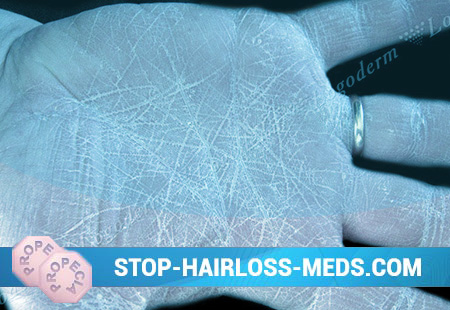What is Generalized Rubromycosis?
Rubromycosis (rubrofitia) is a common fungal disease caused by the fungus Trichophyton rubrum (red trihofitone), which affects the soles, palms, smooth skin, fluff hair and nails.
Pathogenesis during Generalized Rubromycosis
In most cases, this form develops against the background of a long course of limited damage to the skin of the feet (less often and brushes) and nail plates. For the occurrence of generalized rubromycosis, predisposing factors are needed, which are diseases of internal organs, endocrine and nervous systems, trophic skin changes, long-term antibiotics, cytotoxic drugs, steroid hormones.
Symptoms of Generalized Rubromycosis
The clinic is very diverse and is divided into several types: erythematous-squamous (surface), follicular-squamous (deep), exudative forms and damage of the type of erythroderma.
Erythematous-squamous foci of rubromycosis affect any areas of the skin, are accompanied by severe itching and resemble many other skin diseases. This form is distinguished by scalloping in the outlines of foci and a swollen, intermittent roll around the periphery. The process is chronic, exacerbated in the warm season.
Follicular-nodular (deep) form of rubromycosis affects the legs, buttocks and forearms. The elements of this form are capable of forming various shapes. Very often inguinal, interyagic folds, skin under the mammary glands are affected. Foci scaly, their edges rise, have scalloped roller with small papules and crusts. The surface of the lesions has a yellowish-red or brown color.
Diagnosis of Generalized Rubromycosis
The diagnosis is confirmed by microsporia flakes and vellus hair.
Treatment of Generalized Rubromycosis
Apply keratomic ointments, after which make hot baths with potassium permanganate or soda, and then remove the exfoliated stratum corneum. Sometimes 2-3 “detachments” are performed to completely remove the hyperkeratical corneal masses. Then in the morning they carry out lubrication of the lesions with a 2% alcoholic solution of iodine, and in the evenings with 10-15% sulfur ointment with 2-3% tar or Wilkinson ointment. All these procedures are performed within 3 weeks.
Used fungicidal ointment, nitrofungin. Inside prescribed antifungal antibiotic griseofulvina-forte 4-6 tablets per day. Griseofulvin is concentrated in the stratum corneum of the skin, hair, nails, and the fungus loses its ability to penetrate the skin and its appendages. When taking this antibiotic, it is recommended to shave off growing hair every 7-10 days and remove nail plates. These procedures facilitate the healing process. The greatest effect is given by the combined treatment: griseofulvin inside and external procedures. Removal of nail plates produced using keratolytic patches (ureaplast patch containing 20% urea, a patch with 10% trichloroacetic acid, etc.). For these purposes, keratolytic ointments are also used (potassium iodide and lanolin in equal parts).
A surgical method of treatment is applied, i.e., removal of the affected nails with subsequent treatment of the nail bed with antifungal agents.
Prevention of Generalized Rubromycosis
It is necessary to improve the working conditions of workers whose work is related to dust, high humidity, high air temperature (these are workers in the coal and mining industries). Special control is necessary for athletes involved in water sports, employees of baths, showers, pools. In public baths, shower floors, basins, benches, floorings should be treated daily with a 3% solution of clarified bleach, a 5% solution of chlorine bleach or lysol. When visiting public baths, swimming pools, beaches, you must use individual rubber shoes.
In clinics of skin diseases and in dermatologists’ offices, in polyclinics, i.e., wherever patients with mycoses of the feet are treated, all materials (cotton wool, bandages, tampons) are burned or autoclaved, or poured for 2 hours with a 10% clarified solution. bleach, and then destroyed. Medical instruments are boiled for 10 min from the moment of boiling or immersed in 10% formaldehyde solution for 15 min or lysoform solution diluted 2 times.

